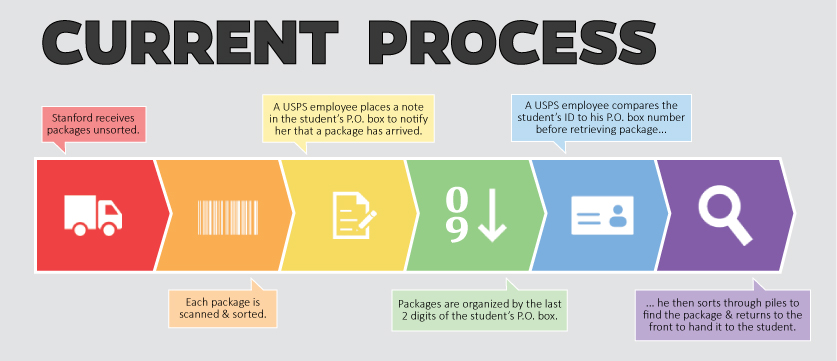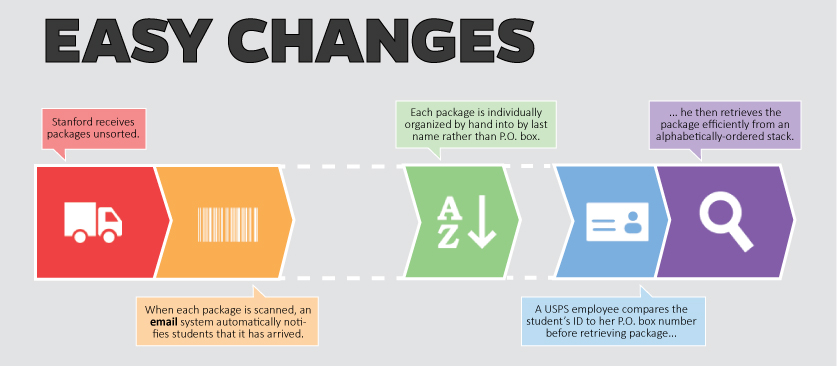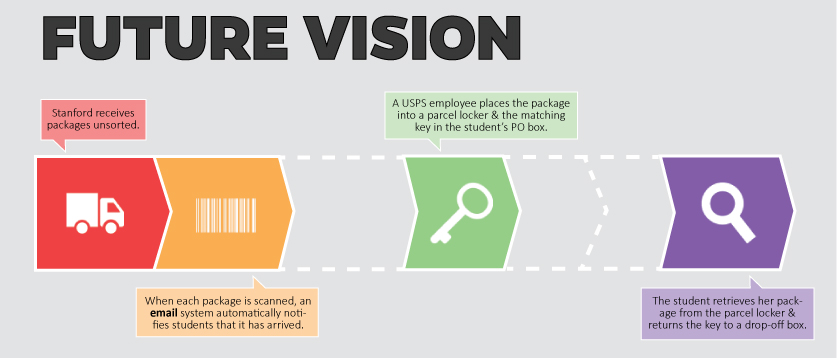Table of Contents
If you’ve received a package through USPS this quarter, you have probably waited at least 45 minutes in line, wondering what it is that’s taking the post office so long to retrieve your packages. As soon as the first classes finish at 9:50AM on Monday morning, there is a line of students wrapping through the lobby and around the P.O. box towers. Students and faculty alike have to miss commitments to wait in line for packages or reschedule their plans to pick up packages during a downtime. One student, after waiting in line for an hour for a small package, voiced his frustration.
“I missed my filming job commitment and felt like I was wasting time,” said sophomore John Louie. “Maybe they could have more than one person retrieving the packages.”
In an interview with Diana Lang, the Stanford Post Office manager, The Review learned about the process a package goes through from delivery to the Post Office to being handed to a student.
Louie is not the only student with ideas to improving the process. We took the challenge to the Stanford community to see if students could come up with solutions and several found opportunities to optimize the pick-up process by identifying both design and business management bottlenecks.
According to Alaa Taha, a junior planning to major in Product Design in the d.school, there are several pressure points in the process of sorting and distributing packages that could be made more efficient.
The first bottleneck that Taha recognized is the notification system in which cards are distributed to each person’s mailbox. “The way they write the cards manually is inefficient,” Taha said. “Because they already scan each package, they could systematically organize everyone’s name and P.O. box number so that when the package is scanned, they could print a notice for each person or send an email saying that your package has arrived.”
Implementing Taha’s suggestion would combine the processes of scanning and card writing, while eliminating the labor required to individually write out each card and put it in its respective P.O. box. The Stanford Post Office receives 1,000 pieces of mail per day on average for over 9,000 P.O. box users. Eliminating a thirty second process for each piece would save hours of labor per day.
Along the same line, a technological approach to notifying customers of their package delivery would save mail recipients time since they would no longer need to manually check their mailbox to ensure their package was delivered. This process has already been implemented at the Roble Package Center.
Taha pointed out another potential point of weakness in the package management process: the package sorting itself. Currently, each package is sorted by the last two digits of the recipients’ P.O. box number. For example, a package for P.O. box 12345 would go on shelf 45, along with any other package addressed to a PO box ending in “45”.
Taha put herself in the shoes of the package retriever who has to find multiple packages for one person: “The 45-shelf packages are all sitting together, but I have to look through all packages on the 45-shelf to find each package as opposed to if it were alphabetical, all of one person’s packages would be put together.” Though sorting all packages alphabetically would take more time than just placing them on the appropriate shelf, customers will not be waiting in line during this time, making it a worthwhile trade-off.
This design change, much like the previous scanning suggestion, could save several seconds per package – which could in turn reduce the wait time in the package pickup line significantly.
Design changes to the delivery notification and package sorting processes would have minimal costs, save users’ time, and may even save the post office labor costs. Miller Aaron, a junior pursuing an MS&E degree and C.O.O. of Stanford Student Enterprises, noted that there are several aspects of the Post Office’s business administration that could cause a long wait time for package pickup.
“I think they’re dealing with more than they have the bandwidth to deal with – they’re understaffed,” suggested Aaron.
The problem of being understaffed is hard to solve cheaply, and hiring another employee is often out of the budget range. Other problems Aaron noticed, however, may be more feasible for the management.
“It could be that they don’t divide their labor as well as they could – if they put another employee in the package pickup window, the line might not be as long as it is now.”
Usually, there is a maximum wait of 10 minutes to send packages and purchase stamps, and a 30 to 60 minute wait for package pickup. Aaron said that from a business perspective, a shift of an employee or two to the package pickup would drastically shorten the pickup line length and save time both for the business and for the consumers.
Aaron also pointed out that the business’s inefficiency might be due, in part, to the minimal incentive structure of a government-run business.
“My guess is that the process itself is not intrinsically inefficient,” Aaron added, “but the lack of incentive to be efficient could lead to the inefficiency.”
If the Stanford Post Office were to get a budget increase, however, Taha suggested several structural changes that would lead to a better package pickup experience for students.
“If you try to eliminate the process of the users having to pick up something from a person, that frees up someone to sort and send packages,” noted Alaa. “If I, as the package sorter, could drop a key in your P.O. box and you didn’t have to go through me to pick up the package, that would be much faster and free up employee resources.”
This suggestion would require an expansion of the current system in which package recipients could pick up certain packages from the parcel lockers in the islands. However, there would need to be a much larger number of package pickup boxes to accommodate all packages that are at the post office at any given time. While it would most likely require a structural renovation of the building, it could free up employee resources and eliminate the need for a package pickup line.
The USPS may not be an organization hailed for business agility, consumer focus, or innovative thinking, but these stereotypes should not discourage one office from trying to improve, especially on a campus famous for its innovation. Cost-effective changes will improve both the speed and the expense of the process, but it is left to be seen whether a governmental organization like the Post Office would choose to embrace such efficiency.






